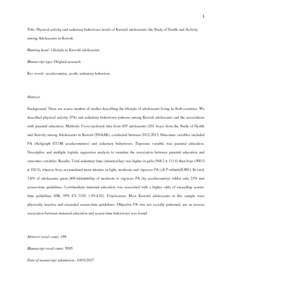Hashem, R; Rey-López, JP; Hamer, M; McMunn, A; Whincup, PH; Owen, CG; Rowlands, A; Stamatakis, E
(2018)
Physical Activity and Sedentary Behaviors Levels of Kuwaiti Adolescents: The Study of Health and Activity Among Adolescents in Kuwait.
J Phys Act Health, 15 (4).
pp. 255-262.
ISSN 1543-5474
https://doi.org/10.1123/jpah.2017-0013
SGUL Authors: Owen, Christopher Grant Whincup, Peter Hynes
![[img]](https://openaccess.sgul.ac.uk/109615/1.hassmallThumbnailVersion/Maindocument_thirdsubmission_original.pdf)  Preview |
|
PDF
Accepted Version
Available under License ["licenses_description_publisher" not defined].
Download (200kB)
| Preview
|
Abstract
BACKGROUND: There is only scarce number of studies available describing the lifestyle of adolescents living in Arab countries. Hence, we described physical activity (PA) and sedentary behaviors patterns among Kuwaiti adolescents and the associations with parental education. METHODS: Cross-sectional data from 435 adolescents (201 boys and 234 girls) were collected from the Study of Health and Activity among Adolescents in Kuwait conducted between 2012 and 2013. Outcome variables included PA (ActiGraph GT1M accelerometers) and sedentary behaviors. Exposure variable was parental education. Descriptive and multiple logistic regression analyses were used to examine the association between parental education and outcome variables. RESULTS: Total sedentary time (minutes per day) was higher in girls [568.2 (111.6)] than in boys [500.0 (102.0)], whereas boys accumulated more minutes in light, moderate, and vigorous PA (all Ps ≤ .001). In total, 3.4% of adolescents spent ≥60 minutes per day of moderate to vigorous PA (by accelerometry), while only 21% met the screen time guidelines. Low/medium maternal education was associated with a higher odds of exceeding screen time guidelines (odds ratio = 2.09; 95% confidence interval, 1.09-4.02). CONCLUSIONS: Most Kuwaiti adolescents in this sample were physically inactive and exceeded screen time guidelines. Objective PA was not socially patterned, yet an inverse association between maternal education and screen time behaviors was found.
| Item Type: |
Article
|
| Additional Information: |
Accepted author manuscript version reprinted, by permission, from Journal of Physical Activity and Health, 2018, 15 (4): 255-262, https://doi.org/10.1123/jpah.2017-0013. © Human Kinetics, Inc. |
| Keywords: |
accelerometry, socioeconomic status, transport to school, youth, Public Health, 1106 Human Movement And Sports Science, 1302 Curriculum And Pedagogy |
| SGUL Research Institute / Research Centre: |
Academic Structure > Population Health Research Institute (INPH) |
| Journal or Publication Title: |
J Phys Act Health |
| ISSN: |
1543-5474 |
| Language: |
eng |
| Dates: |
| Date | Event |
|---|
| April 2018 | Published | | 25 November 2017 | Published Online |
|
| Publisher License: |
Publisher's own licence |
| PubMed ID: |
29172971 |
 |
Go to PubMed abstract |
| URI: |
https://openaccess.sgul.ac.uk/id/eprint/109615 |
| Publisher's version: |
https://doi.org/10.1123/jpah.2017-0013 |
Statistics
Item downloaded times since 13 Feb 2018.
Actions (login required)
 |
Edit Item |



